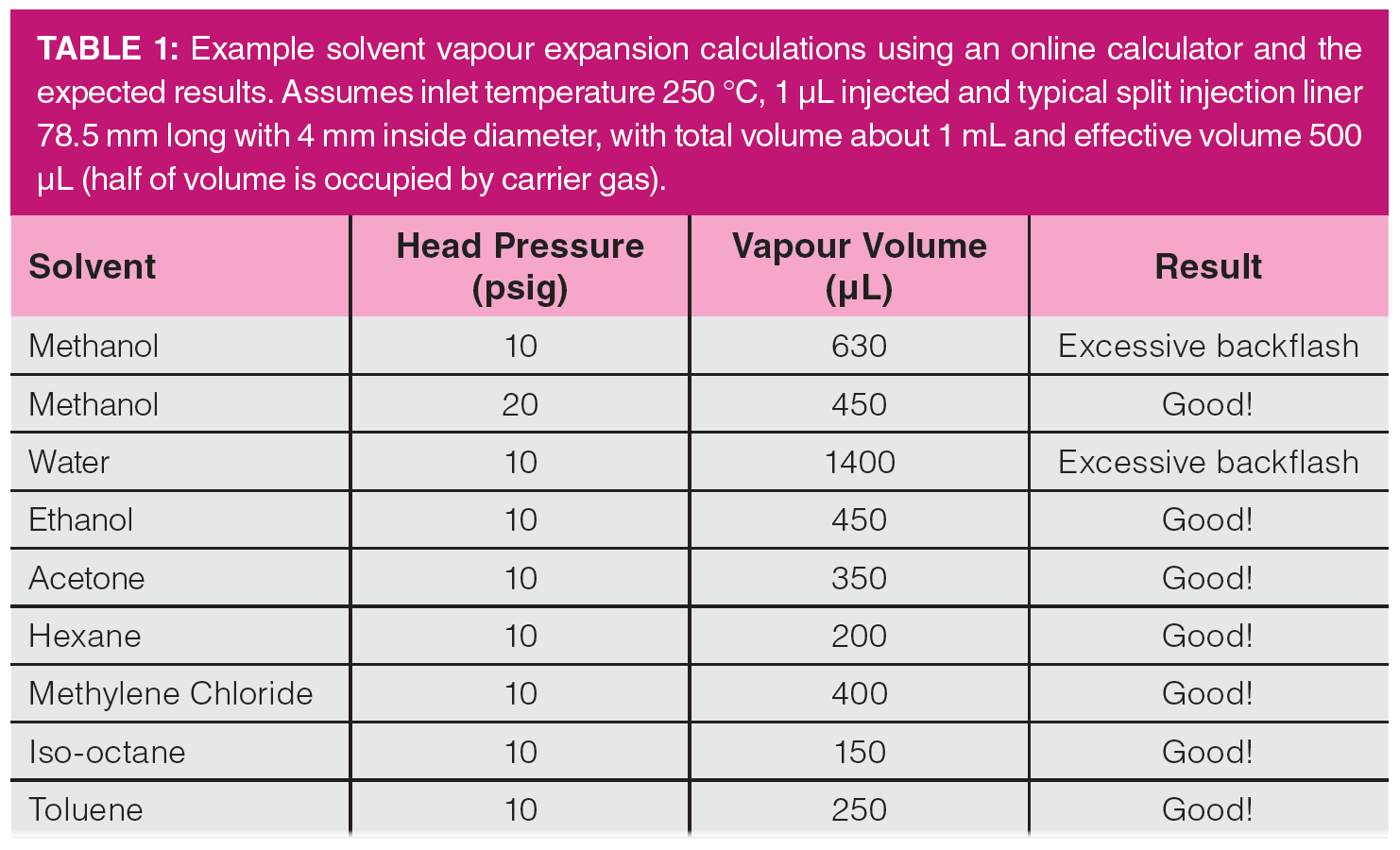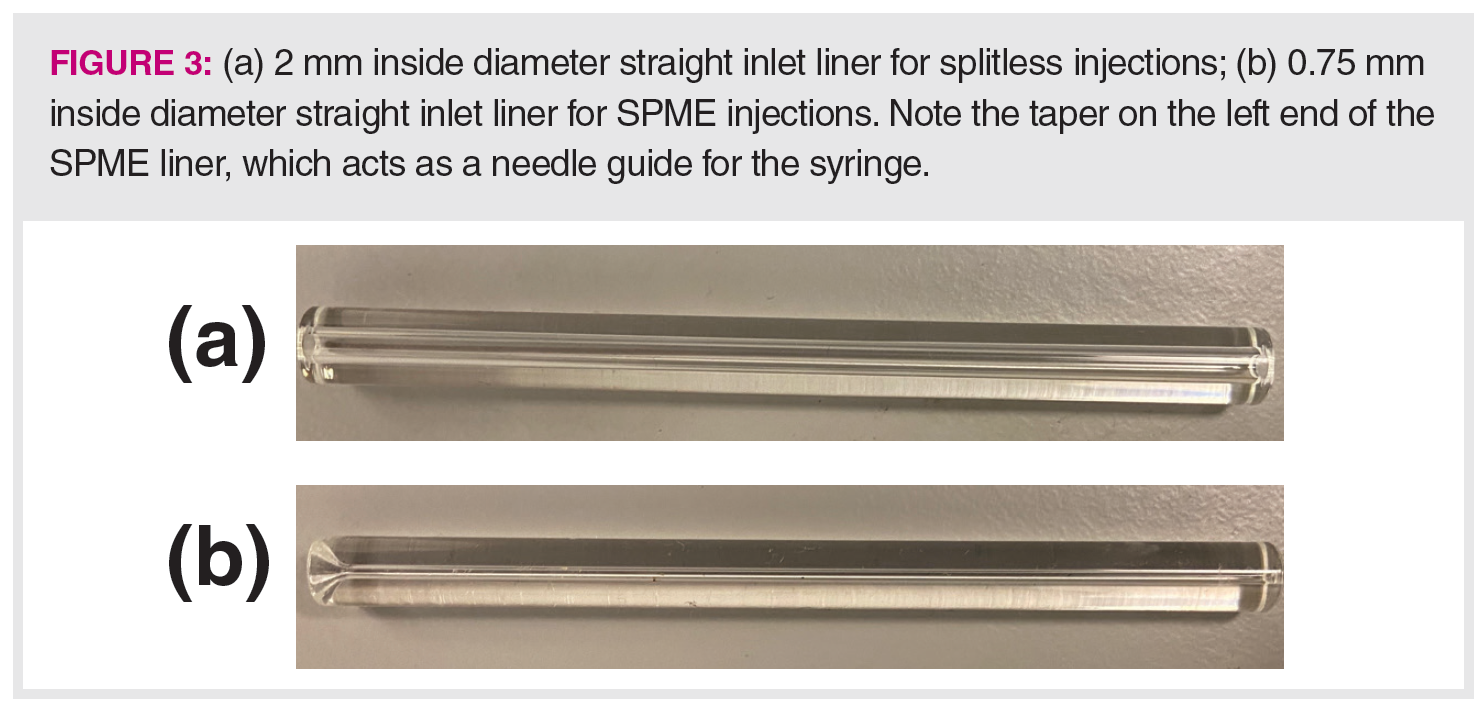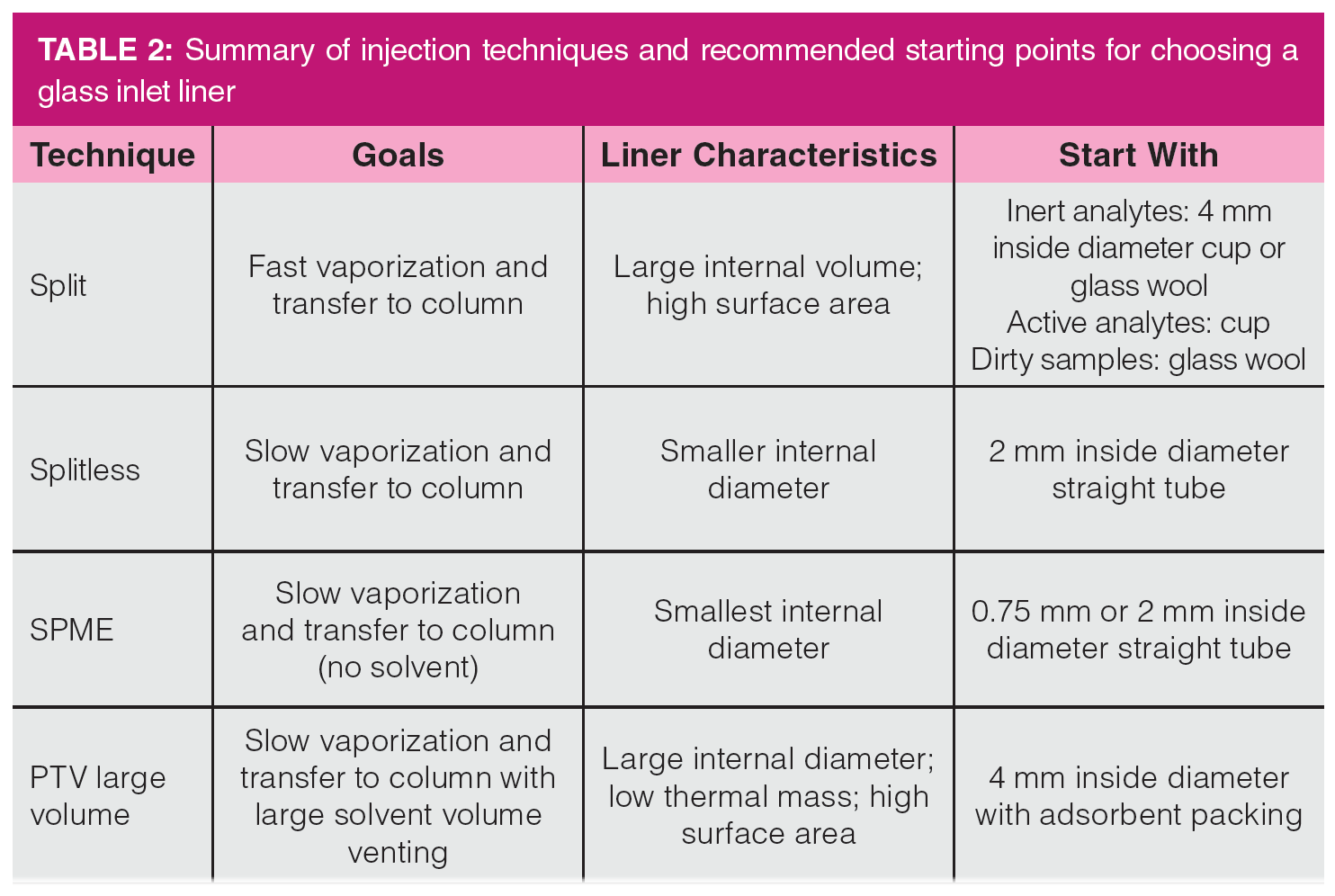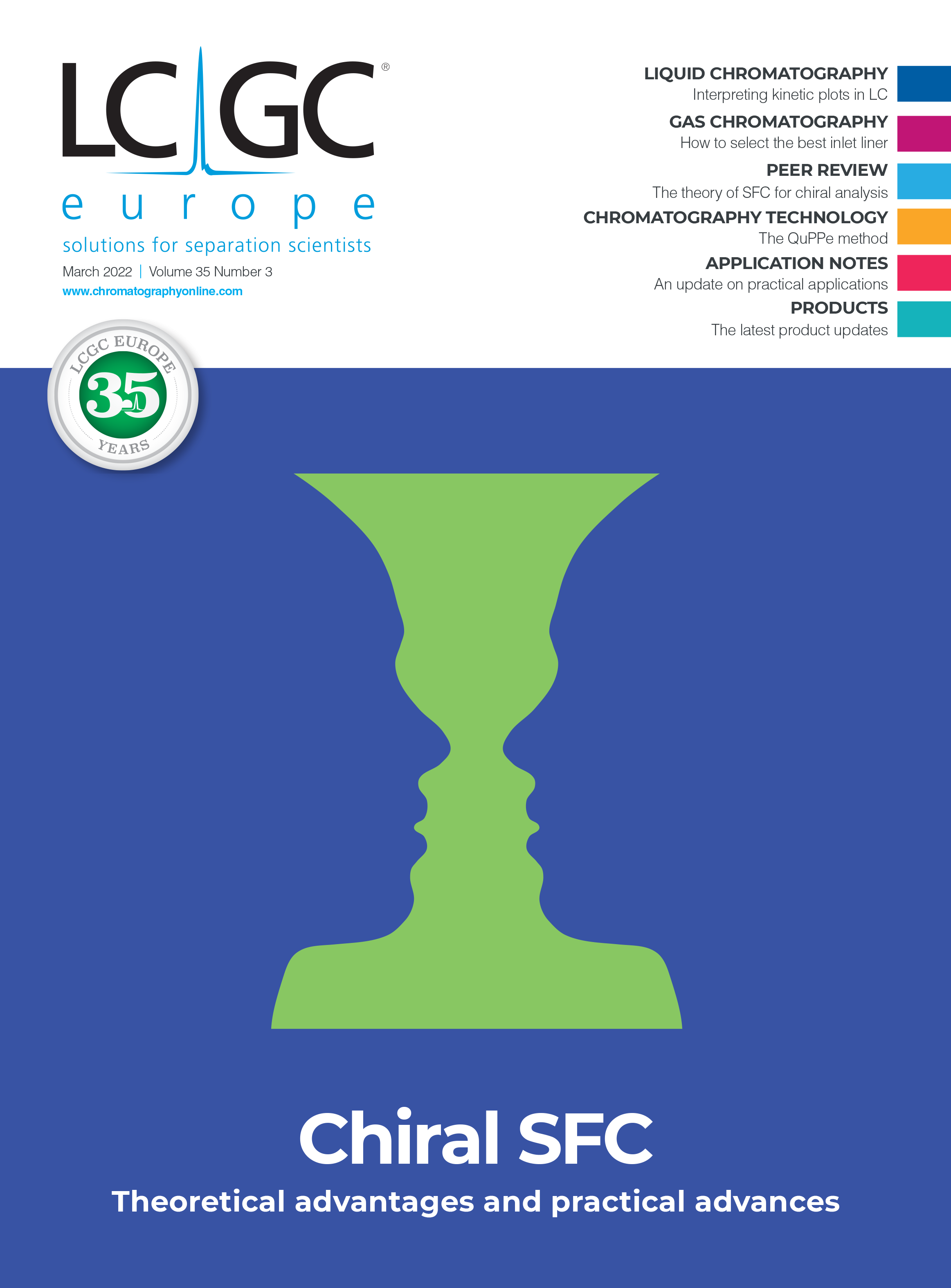Split/Splitless Inlets in GC: What’s Up with All Those Different Glass Inlet Liners?
Over the winter break at the university where I work, I was ordering consumables for the upcoming semester. As I was browsing the web pages at a major vendor for glass inlet liners, I was again impressed by the many glass inlet liner options and geometries available for split and splitless inlets, still by far the most used today. In this instalment, we will review the processes that happen in the inlet when a sample is injected, and use this to make some sense of the many available inlet liner configurations. We will generate some best practices and guidelines in selecting an inlet liner, but we will see that there is no one single liner that fits all situations. Selecting the best inlet liner should be a step in all method development involving split or splitless injections.
Capillary gas chromatography (GC) has always suffered from some fundamental challenges regarding sample introduction into the chromatograph. First, the liquid sample must be transferred from a syringe or other sampling device to an open tubular column that most often has an inside diameter smaller than the syringe. Second, the injected sample must be vaporized and homogeneously mixed with the carrier gas stream. The sample/carrier gas mixture must be quantitatively and reproducibly transferred into the open tube of the capillary column. Finally, the inlet must be large enough to accommodate the full vapour volume generated when the liquid sample is evaporated. As described in the classical book by Grob, Split and Splitless Injection in Capillary Gas Chromatography, the many processes involved with solving these challenges can be very complex, to the tune of this book being nearly 500 pages long (1).
A final challenge involved in transferring a liquid sample into a capillary column is that the entire flow path must be inert. In his book, Grob describes that much research has been done over the years to ensure that the flow path is inert and does not react with or adsorb compounds from the samples. The flow path must also be easy to clean, as it will eventually collect nonvolatile contaminants resulting from sample degradation. All of these challenges led to the development of glass inlet liners to provide an inert flow path that can accommodate the other challenges with vaporization of the sample, mixing with the carrier gas, and transferring that mixture to the column. Figure 1 shows a split/splitless inlet from above, with the top flanges, including the septum and septum nut, removed. Note that the inlet block and gas flow lines are all metal, which can be highly reactive with organic compounds when heated, and would be very difficult to clean. The inlet liner is glass, and usually fits loosely into the inlet body to allow for carrier gas to flow both through the inside of the liner and around the outside. An O-ring provides a gas-tight seal when the flanges and nuts are replaced. Details of the flow paths for split (and splitless) inlets and on general troubleshooting and maintenance of inlet systems are discussed in most texts including gas chromatography and on ChromAcademy, LCGC Europe’s online learning platform (2). As a general maintenance and troubleshooting rule, the glass inlet liner and O-ring should be replaced together on a regular schedule, depending on the cleanliness of the samples being analyzed.

This highlights the need for a removable and replaceable liner for the flow path that also solves the challenges mentioned above. Even more challenging, a liner that works for one sample may not work for another. For the best performance, options must be tested and evaluated. In the remainder of this discussion, we will examine principles of split and splitless injections that inform the choice of liner, beginning with some overriding concerns that govern all liners.
The Two Overriding Concerns: Inertness and Volume
Regardless of the injection technique being used, the inlet liner must be inert to the samples, and must have large enough volume to accommodate the vapour generated when the sample is injected into the heated inlet and vaporized. Depending on the solvent, inlet temperature, and inlet pressure, typical sample solvents used in gas chromatography may generate anywhere from 200 µL to over 1 mL of vapour when evaporated in the inlet. If the volume inside the inlet liner is not large enough, vapour can backflow into the carrier gas lines. Since that vapour will also contain vaporized analytes, those analytes can condense in the gas lines and eventually become eluted as ghost peaks or baseline drift. Solvent vapour volume calculators for common solvents and inlet conditions are available online (3,4). These calculators can be used as guides for choosing the needed volume for the inlet liner. Generally, the chosen liner should have a higher internal volume than provided by the calculator. Table 1 shows vapour volumes generated using the two calculators for some common conditions. Excessive vapour volume occurs in relatively few situations, usually with polar solvents, high injection volumes, or low head pressure. Note that increased head pressure solved the problem with excessive evaporation of water.

The inlet liner must also be inert to any reactive compounds, both analytes and interferences. Nearly all inlet liners for split and splitless inlets are made from glass, which by itself is not deactivated and can have free silanol groups and other surface contaminants that can react with or adsorb analytes. One of the impressive options seen at the vendors’ websites is the choice of deactivation methods, which also should be matched to the expected reactivity of the analytes. Not surprisingly, deactivated inlet liners come at a higher individual price. Being an academic researcher, when developing a method, I used to start with the most inexpensive option and move to the more expensive deactivated liners as needed. Today, I simply purchase deactivated liners up front, so I do not have to find out the hard way, usually through poor peak shapes or poor quantitative reproducibility, that I need to change to a more inert inlet liner. I also purchase deactivated liners from the vendors. I no longer attempt to deactivate them myself.
Next, we discuss glass liner choices for some specific situations, the most common split and splitless injections, and some special cases, including solid-phase microextraction (SPME) and programmed temperature vaporization (PTV) systems.
Liners for Split Injections
An ideal split injection requires that the sample be injected as quickly as possible, vaporized as quickly as possible, and mixed homogeneously with the carrier gas, with the mixture transferred rapidly to the column head. Rapid injection minimizes band broadening and is the primary cause of the sharp peaks characteristic of split injection combined with temperature programming. To assist in vaporization, split liners have a large volume and often have obstructions, baffles, or packing (glass wool or adsorbent) to facilitate vaporization. Figure 2 shows a typical cup-design glass inlet liner and two glass wool packed liners for split injections. I usually start with the cup design, developed by Jennings and often referred to as the “Jennings cup” (5). The cup and associated tubing provide a flow path that assists with vaporization by the large surface area and mixing by the twisted flow path. In Figure 2, the cup is highlighted by the yellow oval. Glass wool and baffles provide a less expensive alternative (especially glass wool for samples with a “dirty” matrix), but both can be challenging with reactive analytes; if active analytes are involved, I recommend the additional expense of deactivated liners. If you look closely at Figure 2(c), you will see some contamination in the glass wool, providing evidence of the main challenge of using glass wool.

Liners For Splitless Injections
Splitless injection is a much slower process than split. A rapid injection with the syringe is followed by a slow evaporation and transfer of the vaporized sample to the column head. To reduce the band broadening caused by the slow sample transfer to the column, temperature programming is almost always used with splitless injections. The inlet liner for splitless injections must be a trade-off between adequate internal volume to accommodate solvent vapour and reasonable transfer time for the vapour phase solvent/solute/carrier gas mixture to the column. The classical liner is a straight glass tube with about 2 mm inside diameter, as seen in Figure 3(a). A splitless liner usually has a smaller internal volume than for split. This is partially compensated by slower vaporization, but the liner volume should still be confirmed using a vapour volume calculator. The tube ends may be tapered or goosenecked to assist with column installation or syringe insertion. The liner may also be packed with glass wool or an adsorbent material to facilitate solvent and sample vaporization.

Special Liners: SPME and PTV
Most injections using solid-phase microextraction (SPME) are a special application of a split/splitless inlet in which no solvent is used. Since no solvent is used there is no need for a large volume to accommodate solvent vapour. Since there is no need for a large volume, a small, 0.75 mm inside diameter straight tube inlet liner is most commonly used. One advantage of SPME injections is that there is no solvent, so there is no need for the inlet liner to have a large internal volume; in fact, the smallest possible volume is best to reduce band broadening during the injection process. Figure 3(b) shows a typical glass liner for SPME. Note the vary narrow inside diameter, which is possible since there is no solvent vapour, and the taper at one end, which provides a guide for the needle to fit more easily into the small diameter. In the early days of SPME, my group wrote on the details of optimizing SPME injections using the split/splitless inlet (6). The narrow diameter liner becomes more critical as the analytes become more volatile. For semi-volatile analytes, a traditional straight splitless liner will often work.
You may have a programmed temperature vaporization (PTV) or multimode inlet that is capable of several injection techniques in a single platform. The basics of these inlets were discussed in a previous “GC Connections” instalment (7). If temperature programmed inlets are used, the inlet and the inlet liner must have a low thermal mass for rapid heating and cooling, so inlet liners are typically large internal volume with thin glass walls. If large volume injections are performed, the inlet liner usually contains an adsorbent to accommodate the large volume of injected liquid solvent.
Choosing a Liner
Basic characteristics of inlet liners for specific injections methods are summarized in Table 2, along with my recommendations for a starting point in method development.

When I am choosing inlet liners, I start simple. For split injections, I start with a classical cup design, which, while a little more expensive than some of the other options, provides a large space for vapour expansion and a high heated surface area to aid in sample vaporization. Also, the cup prevents an accidental “lucky shot” in which the liquid stream from the syringe shoots straight into the column. For splitless, I prefer to start with a 2 mm inside diameter straight tube, with no glass wool or other obstructions. I then consider options for a modified flow path, such as glass wool, should my evaluation of the data dictate, usually by seeing unsatisfactory quantitative reproducibility for repeated injections of standards. The challenge with choosing a glass inlet liner is that there is no solution that fits all analyses and situations. Once a starting point is chosen, if the results are not satisfactory, alternatives must be selected and tried by experimentation. Finally, when choosing a glass liner for a specific application, the classic first steps in method development particularly apply: check the applications literature, and contact the vendor for advice as well as ask someone who knows.
Conclusions
The glass inlet liner is one of the most important, yet least understood and most often ignored, components of a gas chromatographic experiment. It is the critical link between sample preparation and separation by the column. The best sample preparation and the best column can be ruined by a poor choice of glass liner. Unfortunately, there is no “killer app” for choosing an appropriate glass inlet liner. Users are best served by making an intelligent first choice, usually simple, and appropriate to the injection technique (split or splitless) being used, thinking about the expected chemistry of their samples and standards and making changes, such as from cup to baffles to inserting glass wool, as analytical and chromatographic performance dictate. Not all glass inlet liners are alike, and not all will solve every problem. For best performance, they must be studied by experiment.
References
- K. Grob, Split and Splitless Injection for Quantitative Gas Chromatography: Concepts, Processes, Practical Guidelines, Sources of Error (John Wiley and Sons, Hoboken, New Jersey, USA, 4th Ed., 2001).
- “GC Sample Introduction” ChromAcademy, https://www.chromacademy.com/channels/gc-training-courses/instrumentation/gc-sample-introduction/ (accessed February 2022).
- Agilent Solvent Vapour Calculator, https://www.agilent.com/en/support/gas-chromatography/gccalculators (accessed February 2022).
- Restek Solvent Expansion Calculator, https://www.restek.com/en/tools-and-calculators/tools/solvent-expansion-calculator/ (accessed February 2022).
- W.G. Jennings, J. Chromatogr. Sci. 13, 185 (1975).
- P.D. Okeyo and N.H. Snow, LCGC North Am. 15(12), 1130–1136 (1997).
- N.H. Snow, LCGC Europe 33(7), 347–351 (2020).
About The Author
Nicholas H. Snow is the Founding Endowed Professor in the Department of Chemistry and Biochemistry at Seton Hall University, and an Adjunct Professor of Medical Science. Direct correspondence to: amatheson@mjhlifesciences.com

Accelerating Monoclonal Antibody Quality Control: The Role of LC–MS in Upstream Bioprocessing
This study highlights the promising potential of LC–MS as a powerful tool for mAb quality control within the context of upstream processing.
Using GC-MS to Measure Improvement Efforts to TNT-Contaminated Soil
April 29th 2025Researchers developing a plant microbial consortium that can repair in-situ high concentration TNT (1434 mg/kg) contaminated soil, as well as overcome the limitations of previous studies that only focused on simulated pollution, used untargeted metabolone gas chromatography-mass spectrometry (GC-MS) to measure their success.
Prioritizing Non-Target Screening in LC–HRMS Environmental Sample Analysis
April 28th 2025When analyzing samples using liquid chromatography–high-resolution mass spectrometry, there are various ways the processes can be improved. Researchers created new methods for prioritizing these strategies.
Potential Obstacles in Chromatographic Analyses Distinguishing Marijuana from Hemp
April 28th 2025LCGC International's April series for National Cannabis Awareness Month concludes with a discussion with Walter B. Wilson from the National Institute of Standard and Technology’s (NIST’s) Chemical Sciences Division regarding recent research his team conducted investigating chromatographic interferences that can potentially inflate the levels of Δ9-THC in Cannabis sativa plant samples, and possible solutions to avoid this problem.

.png&w=3840&q=75)

.png&w=3840&q=75)



.png&w=3840&q=75)



.png&w=3840&q=75)









